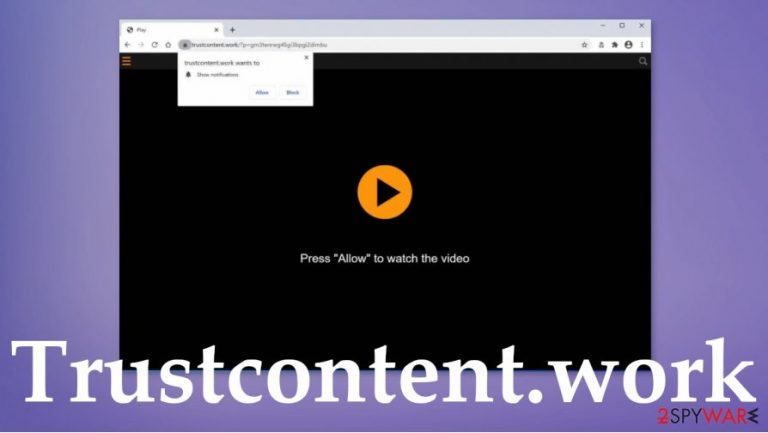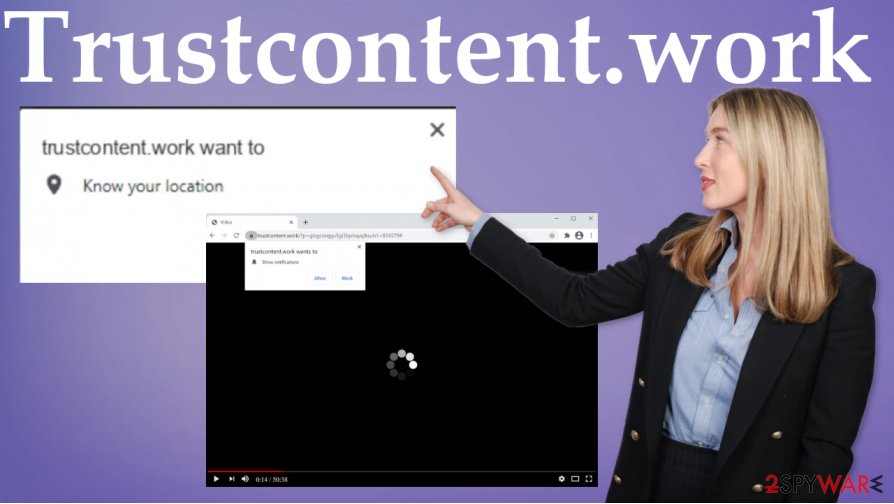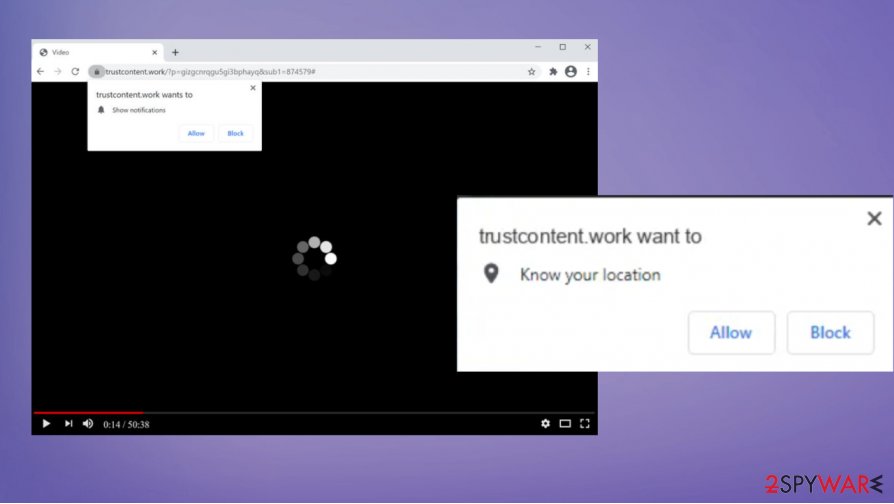Trustcontent.work (Removal Instructions) - Free Guide
Trustcontent.work Removal Guide
What is Trustcontent.work?
Trustcontent.work is the adware-type program that controls the online traffic

Trustcontent.work is the program that is considered potentially unwanted because it shows pop-ups, commercial content, redirects, advertisements, and controls the traffic like this. It is easily achievable with shady push notifications and other forms of ads like banners, links. The adware-type intruder aims to collect views, page visits, and interfere with continuous malvertising[1] behavior. The intruder is possibly malicious because it is focused on affecting time online with redirects, advertisements, pop-ups. The main goal of the infection like this that works on the web browser is to generate revenue[2] for the publisher, sponsor, other third-parties. However, this involvement also means that PUP is collecting data, and so does third-party companies. You should remove the adware as soon as you notice any issues, so there is no privacy or identity theft issue.
| Name | Trustcontent.work |
|---|---|
| Type | Push notification virus/ adware |
| Spreading methods | The injection of the pop-up virus begins after the “Allow” button is pressed, so you can let the adware program on the machine without even noticing |
| Symptoms | Users start seeing pop-ups on their desktops at any time when the machine is turned on. Notifications come directly to your screen even when the browser is closed |
| Dangers | Clicking on links that are embedded within the notification prompt, exploring the sites these links bring to, or downloading files can be particularly dangerous – users can get infected with malware, suffer from financial losses or privacy issues |
| Elimination | Redirects and ads might indicate adware infection, so you should check your system with anti-malware to remove Trustcontent.work |
| Further steps | You should also take care of the PUP damage, so clean your browsers, and attempt to fix virus damage with a repair tool FortectIntego |
Trustcontent.work is the program designed to show advertisements and pop-ups, so the user inadvertently allowing push notifications that go straight to the screen of the victim. Unfortunately, there is nothing malicious about the site itself, if you manage to avoid clicking on any content.
However, the redirecting behavior and spamming with ads are triggered by the PUP that runs in the background. This what controls all the Trustcontent.work pop-ups and notifications. You need to run proper tools like antivirus applications or SpyHunter 5Combo Cleaner, Malwarebytes, so the intruder is removed fully.
To prevent the site from displaying notifications, you can access the site permission section via your web browser settings. However, it is not easy, so you need more automatic Trustcontent.work removal options before you can go for any manual changes and alterations.

You can remove Trustcontent.work freely without any hesitation. It is not creating any serious issues and not giving any value for the machine, but third-party involvement is not welcome and cannot lead to any positive things. Collecting your browsing-related information is not okay nor welcome.
You should ignore these pop-ups, and try to avoid clicking on them, so you do not need to terminate other PUPs besides the Trustcontent.work itself:
Trustcontent.work wants to Show notifications
Click Allow to watch the video
Trustcontent.work is a PUP that alters files, functions, or programs, so the machine is more controlled by the intruder, not the user. This how adware becomes persistent and annoying. Make sure to get rid of the intrusive threat and repair damage using FortectIntego or a similar tool.

PUPs spread around during freeware installations
You need to pay attention to details and go for secure sites, official sources of programs. This is the main way for the PUP developers to distribute their products using the internet and gullible users' habits. There are many issues that can occur when the program gets installed.
If you go for a not secure source and choose Recommended or Quick installs, you trigger the program download that also comes with additional apps. Going for Advanced or Custom installations can save you time later on because you avoid unwanted programs infiltration.
Trustcontent.work removal steps should include direct setting changes for the proper recovery
You interact with various Trustcontent.work virus symptoms including pop-ups, ads, redirects. You should note that besides being annoying and intrusive this PUP also can install various browser extensions and change notification settings.
The best way to revert changes is to manually change these preferences on the browser. Experts[3] note that you need to change notification preferences yourself, AV tools or PC optimizers cannot do so. Follow the steps after Trustcontent.work removal:
- Go to Settings or Preferences on your browser.
- These types of programs affect Google Chrome or Safari browsers, but make sure to check all of them on the affected device.
- Move to Settings in the menu.
- Find Advanced option, you should select the Privacy and security section.
- You should be able to find Content settings where you need to select Notifications.
- On the list click Block instead of Allow and make sure to Remove Trustcontent.work, other similar pages.
- Repeat these steps on every browser you use or own.
You should remove Trustcontent.work from browsers, the system, and make sure to terminate the PUP that caused all the issues, behavior, triggered alterations, file corruption. It is important and crucial because your device can be affected by additional installs too.
You may remove virus damage with a help of FortectIntego. SpyHunter 5Combo Cleaner and Malwarebytes are recommended to detect potentially unwanted programs and viruses with all their files and registry entries that are related to them.
Getting rid of Trustcontent.work. Follow these steps
Uninstall from Windows
Recovering from the PUP infection can be difficult. Rely on the guide
Instructions for Windows 10/8 machines:
- Enter Control Panel into Windows search box and hit Enter or click on the search result.
- Under Programs, select Uninstall a program.

- From the list, find the entry of the suspicious program.
- Right-click on the application and select Uninstall.
- If User Account Control shows up, click Yes.
- Wait till uninstallation process is complete and click OK.

If you are Windows 7/XP user, proceed with the following instructions:
- Click on Windows Start > Control Panel located on the right pane (if you are Windows XP user, click on Add/Remove Programs).
- In Control Panel, select Programs > Uninstall a program.

- Pick the unwanted application by clicking on it once.
- At the top, click Uninstall/Change.
- In the confirmation prompt, pick Yes.
- Click OK once the removal process is finished.
Delete from macOS
Remove items from Applications folder:
- From the menu bar, select Go > Applications.
- In the Applications folder, look for all related entries.
- Click on the app and drag it to Trash (or right-click and pick Move to Trash)

To fully remove an unwanted app, you need to access Application Support, LaunchAgents, and LaunchDaemons folders and delete relevant files:
- Select Go > Go to Folder.
- Enter /Library/Application Support and click Go or press Enter.
- In the Application Support folder, look for any dubious entries and then delete them.
- Now enter /Library/LaunchAgents and /Library/LaunchDaemons folders the same way and terminate all the related .plist files.

Remove from Microsoft Edge
Delete unwanted extensions from MS Edge:
- Select Menu (three horizontal dots at the top-right of the browser window) and pick Extensions.
- From the list, pick the extension and click on the Gear icon.
- Click on Uninstall at the bottom.

Clear cookies and other browser data:
- Click on the Menu (three horizontal dots at the top-right of the browser window) and select Privacy & security.
- Under Clear browsing data, pick Choose what to clear.
- Select everything (apart from passwords, although you might want to include Media licenses as well, if applicable) and click on Clear.

Restore new tab and homepage settings:
- Click the menu icon and choose Settings.
- Then find On startup section.
- Click Disable if you found any suspicious domain.
Reset MS Edge if the above steps did not work:
- Press on Ctrl + Shift + Esc to open Task Manager.
- Click on More details arrow at the bottom of the window.
- Select Details tab.
- Now scroll down and locate every entry with Microsoft Edge name in it. Right-click on each of them and select End Task to stop MS Edge from running.

If this solution failed to help you, you need to use an advanced Edge reset method. Note that you need to backup your data before proceeding.
- Find the following folder on your computer: C:\\Users\\%username%\\AppData\\Local\\Packages\\Microsoft.MicrosoftEdge_8wekyb3d8bbwe.
- Press Ctrl + A on your keyboard to select all folders.
- Right-click on them and pick Delete

- Now right-click on the Start button and pick Windows PowerShell (Admin).
- When the new window opens, copy and paste the following command, and then press Enter:
Get-AppXPackage -AllUsers -Name Microsoft.MicrosoftEdge | Foreach {Add-AppxPackage -DisableDevelopmentMode -Register “$($_.InstallLocation)\\AppXManifest.xml” -Verbose

Instructions for Chromium-based Edge
Delete extensions from MS Edge (Chromium):
- Open Edge and click select Settings > Extensions.
- Delete unwanted extensions by clicking Remove.

Clear cache and site data:
- Click on Menu and go to Settings.
- Select Privacy, search and services.
- Under Clear browsing data, pick Choose what to clear.
- Under Time range, pick All time.
- Select Clear now.

Reset Chromium-based MS Edge:
- Click on Menu and select Settings.
- On the left side, pick Reset settings.
- Select Restore settings to their default values.
- Confirm with Reset.

Remove from Mozilla Firefox (FF)
Remove dangerous extensions:
- Open Mozilla Firefox browser and click on the Menu (three horizontal lines at the top-right of the window).
- Select Add-ons.
- In here, select unwanted plugin and click Remove.

Reset the homepage:
- Click three horizontal lines at the top right corner to open the menu.
- Choose Options.
- Under Home options, enter your preferred site that will open every time you newly open the Mozilla Firefox.
Clear cookies and site data:
- Click Menu and pick Settings.
- Go to Privacy & Security section.
- Scroll down to locate Cookies and Site Data.
- Click on Clear Data…
- Select Cookies and Site Data, as well as Cached Web Content and press Clear.

Reset Mozilla Firefox
If clearing the browser as explained above did not help, reset Mozilla Firefox:
- Open Mozilla Firefox browser and click the Menu.
- Go to Help and then choose Troubleshooting Information.

- Under Give Firefox a tune up section, click on Refresh Firefox…
- Once the pop-up shows up, confirm the action by pressing on Refresh Firefox.

Remove from Google Chrome
You should clean the machine properly, so resetting the browser helps with traces of the cyber threat
Delete malicious extensions from Google Chrome:
- Open Google Chrome, click on the Menu (three vertical dots at the top-right corner) and select More tools > Extensions.
- In the newly opened window, you will see all the installed extensions. Uninstall all the suspicious plugins that might be related to the unwanted program by clicking Remove.

Clear cache and web data from Chrome:
- Click on Menu and pick Settings.
- Under Privacy and security, select Clear browsing data.
- Select Browsing history, Cookies and other site data, as well as Cached images and files.
- Click Clear data.

Change your homepage:
- Click menu and choose Settings.
- Look for a suspicious site in the On startup section.
- Click on Open a specific or set of pages and click on three dots to find the Remove option.
Reset Google Chrome:
If the previous methods did not help you, reset Google Chrome to eliminate all the unwanted components:
- Click on Menu and select Settings.
- In the Settings, scroll down and click Advanced.
- Scroll down and locate Reset and clean up section.
- Now click Restore settings to their original defaults.
- Confirm with Reset settings.

Delete from Safari
Remove unwanted extensions from Safari:
- Click Safari > Preferences…
- In the new window, pick Extensions.
- Select the unwanted extension and select Uninstall.

Clear cookies and other website data from Safari:
- Click Safari > Clear History…
- From the drop-down menu under Clear, pick all history.
- Confirm with Clear History.

Reset Safari if the above-mentioned steps did not help you:
- Click Safari > Preferences…
- Go to Advanced tab.
- Tick the Show Develop menu in menu bar.
- From the menu bar, click Develop, and then select Empty Caches.

After uninstalling this potentially unwanted program (PUP) and fixing each of your web browsers, we recommend you to scan your PC system with a reputable anti-spyware. This will help you to get rid of Trustcontent.work registry traces and will also identify related parasites or possible malware infections on your computer. For that you can use our top-rated malware remover: FortectIntego, SpyHunter 5Combo Cleaner or Malwarebytes.
How to prevent from getting adware
Stream videos without limitations, no matter where you are
There are multiple parties that could find out almost anything about you by checking your online activity. While this is highly unlikely, advertisers and tech companies are constantly tracking you online. The first step to privacy should be a secure browser that focuses on tracker reduction to a minimum.
Even if you employ a secure browser, you will not be able to access websites that are restricted due to local government laws or other reasons. In other words, you may not be able to stream Disney+ or US-based Netflix in some countries. To bypass these restrictions, you can employ a powerful Private Internet Access VPN, which provides dedicated servers for torrenting and streaming, not slowing you down in the process.
Data backups are important – recover your lost files
Ransomware is one of the biggest threats to personal data. Once it is executed on a machine, it launches a sophisticated encryption algorithm that locks all your files, although it does not destroy them. The most common misconception is that anti-malware software can return files to their previous states. This is not true, however, and data remains locked after the malicious payload is deleted.
While regular data backups are the only secure method to recover your files after a ransomware attack, tools such as Data Recovery Pro can also be effective and restore at least some of your lost data.
- ^ Malvertising. Wikipedia. The free encyclopedia.
- ^ Pay-per-click and paid search advertising. Nibusinessinformation. sales and marketing.
- ^ Avirus. Avirus. Spyware related news.
